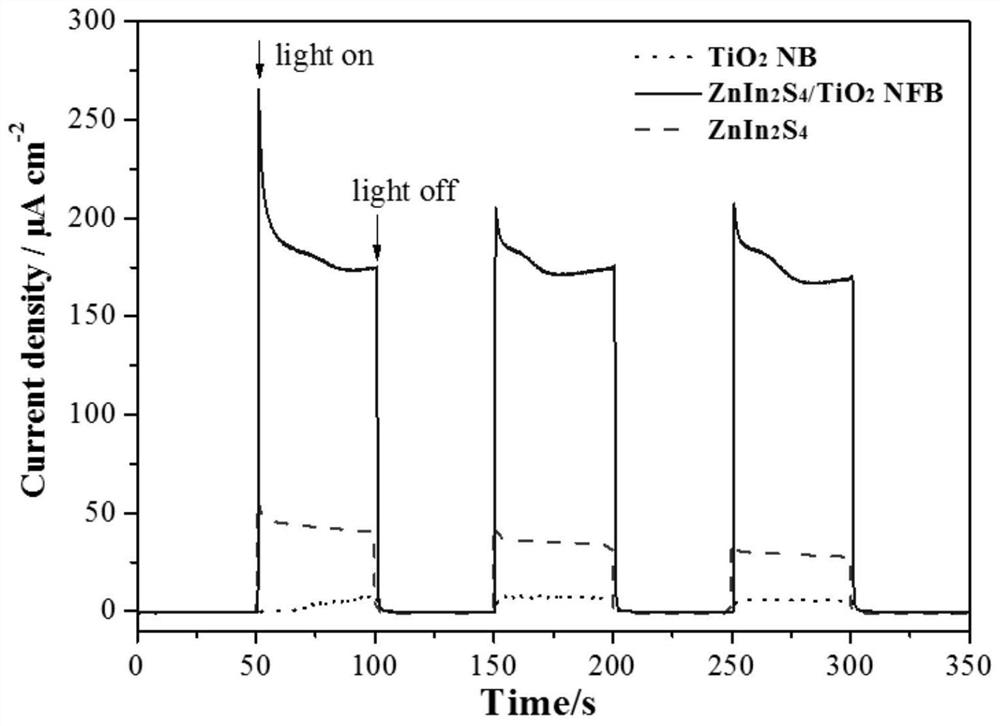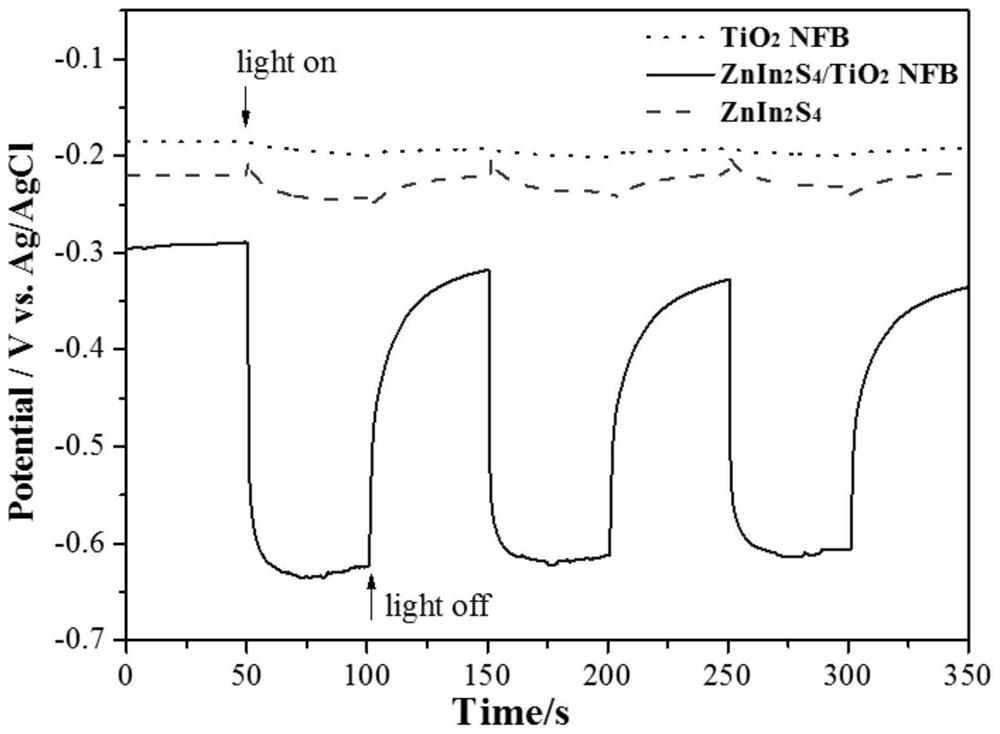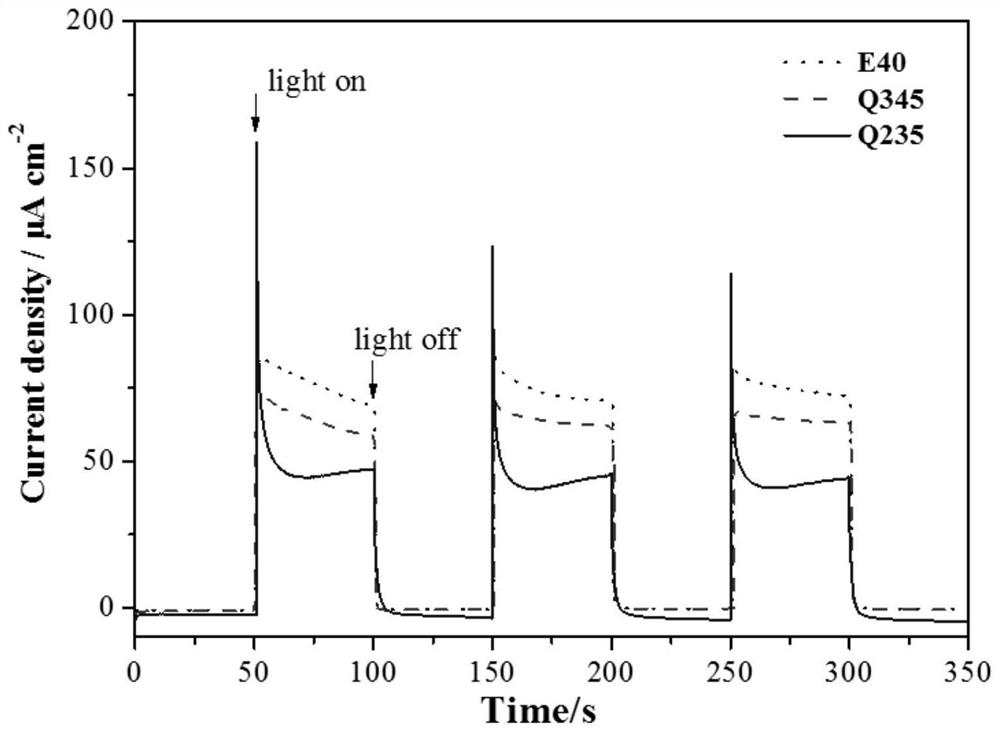Nano-grass composite photoelectric material for photoelectrochemical cathodic protection and its preparation and application
A technology for optoelectronic materials and cathodic protection, applied in photovoltaic power generation, final product manufacturing, sustainable manufacturing/processing, etc., can solve the problems of limited optoelectronic performance, narrow spectral response range, easy recombination, etc., to achieve good transmission performance, photoelectric conversion. Efficiency improvement, effect of large light-capturing area
- Summary
- Abstract
- Description
- Claims
- Application Information
AI Technical Summary
Problems solved by technology
Method used
Image
Examples
Embodiment 1
[0038] ZnIn for photoelectrochemical cathodic protection 2 S 4 / TiO 2 Preparation of nanograss composite optoelectronic materials:
[0039] 1) Preparation of FTO conductive glass: first cut the FTO glass into 20×10mm 2 size, then ultrasonically cleaned in analytical pure acetone for 5 minutes, and then cleaned in deionized water for 5 minutes, and then the FTO glass was dried for use.
[0040] 2) TiO 2 Preparation of nano-grass substrate: place the FTO conductive glass treated in step 1) in the inner liner of the autoclave, place the conductive surface downward at an angle of 45° with the autoclave wall, and add solution a to the autoclave to immerse the glass substrate material, and then hydrothermally heated at 180 °C for 9 hours. After the hydrothermal treatment, the FTO glass was taken out, repeatedly rinsed with deionized water and dried, and then annealed at 450 °C for 1 hour to obtain TiO 2 Nanograss film substrates (see figure 1 a and b). Wherein, solution a is...
Embodiment 2
[0051] ZnIn for photoelectrochemical cathodic protection 2 S 4 / TiO 2 Preparation of nanograss composite optoelectronic materials:
[0052] 1) Preparation of FTO conductive glass: first cut the FTO glass into 20×10mm 2 size, then ultrasonically cleaned in analytical pure acetone for 5 minutes, and then cleaned in deionized water for 5 minutes, and then the FTO glass was dried for use.
[0053] 2) TiO 2 Preparation of nano-grass substrate: place the FTO conductive glass treated in step 1) in the inner liner of the autoclave, place the conductive surface downward at an angle of 45° with the autoclave wall, and add solution a to the autoclave to immerse the glass substrate material, and then hydrothermally heated at 180 °C for 9 hours. After the hydrothermal treatment, the FTO glass was taken out, repeatedly rinsed with deionized water and dried, and then annealed at 450 °C for 1 hour to obtain TiO 2 Nanograss film substrate. Wherein, solution a is a solution obtained by a...
PUM
| Property | Measurement | Unit |
|---|---|---|
| electric potential / voltage | aaaaa | aaaaa |
Abstract
Description
Claims
Application Information
 Login to View More
Login to View More - R&D
- Intellectual Property
- Life Sciences
- Materials
- Tech Scout
- Unparalleled Data Quality
- Higher Quality Content
- 60% Fewer Hallucinations
Browse by: Latest US Patents, China's latest patents, Technical Efficacy Thesaurus, Application Domain, Technology Topic, Popular Technical Reports.
© 2025 PatSnap. All rights reserved.Legal|Privacy policy|Modern Slavery Act Transparency Statement|Sitemap|About US| Contact US: help@patsnap.com



